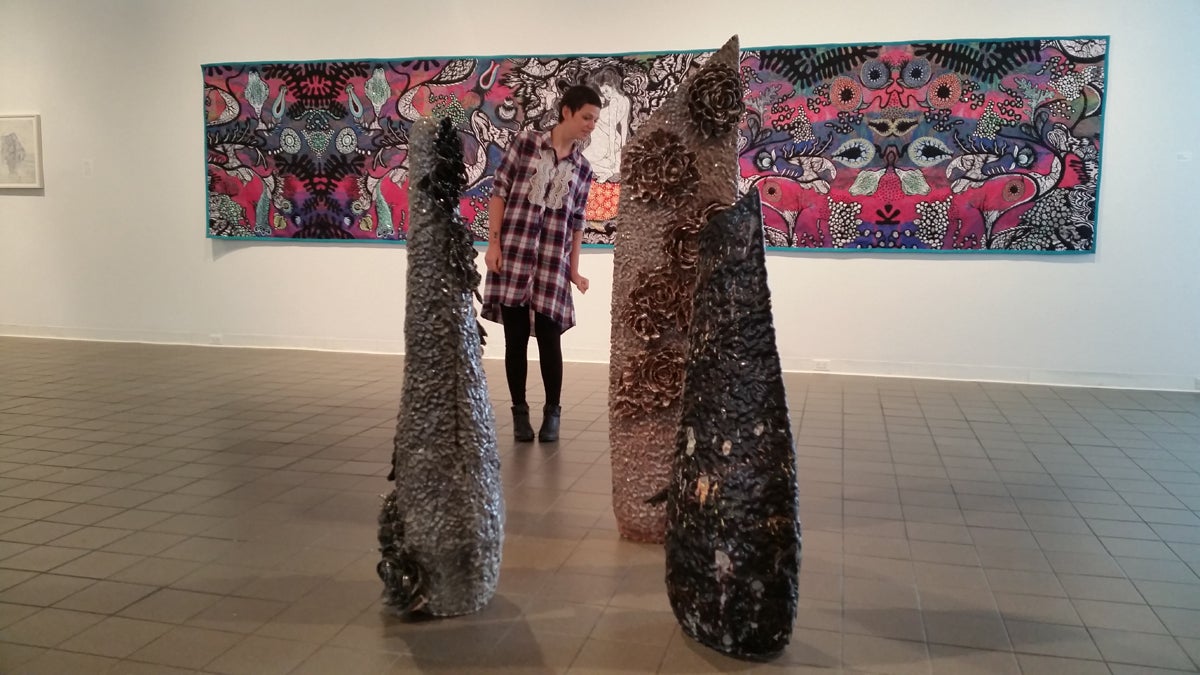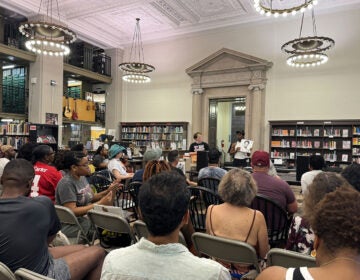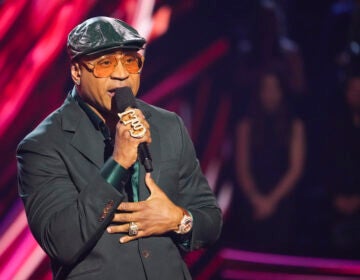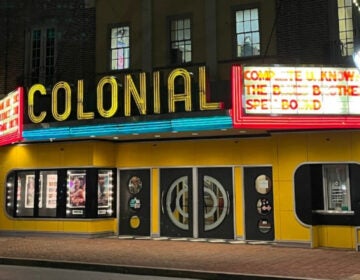Interactive art installation at Moore aims to elicit unexpected reactions

Moore College of Art senior Katie O'Neil ponders "Body Ceramics" by Julie Bunn. (Peter Crimmins/WHYY)
Katie O’Neil is a senior at Moore College of Art, studying painting, performance, and video. She has spent years defending her artwork in heated critical sessions.
“I look at art — especially my own — thinking of myself as a lawyer,” said O’Neil, who is preparing for more of the same as she goes on to graduate school. “When I present it, I really need to understand why I’m choosing the formalistic qualities, what is the idea, what the audience supposed to get out of it, what am I supposed to get out of it. If I can’t answer all these questions, it’s back to the drawing board.”
She took a brief respite from cutthroat classroom critiques during a workshop in the Galleries at Moore, where O’Neil was taken through a series of exercises designed to elicit a radically subjective response to the current faculty exhibition, “Altered States.”
Participants were asked to contort their bodies into a shape responsive to the art; imagine a sound the art would make, and vocalize it; write a love letter to the work. Or, alternately, a breakup letter.
O’Neil considered a trio of large ceramic totemlike sculptures, “Body Ceramics” by Julia Bunn.
“I was thinking of it as a cathedral, because it’s so hollow inside, like aaaaaaah,” she said, making a soprano cry like a chord of a gospel choir. “That would be the sound it would make. But that’s not something we normally do.”
The workshop is the project of Matt Kalasky, Moore’s education coordinator. He designed it with whimsy and a touch of absurdity, to knock the needle out of people’s artistic groove.
“A big part is getting them to respond in a way that’s unexpected. To consider a range of ways art is affecting you,” said Kalasky. “Physically, emotionally, psychologically, all those spectrums might not get emphasis in a traditional response.”
Museums and galleries traditionally tell the story of how and why artists make particular piece of art, and how they fit into the larger sweep of art history. Kalasky wants to consider the viewer.
“All these stories put together create a much more engaged experience – much richer, more nuanced and rewarding experience with art, than just focusing on why the artist made this or what history it had,” he said. “The point is to fit this into the story of you.”
Kalasky led a series of workshops with a range of people — from art students at Moore, older people taking drop-in classes, high school students on field trips — that culminated in recordings of love letters they wrote to particular pieces. Those recordings make up a gallery audio tour, “Art Crush.”
Visitors to the gallery can use their smart phones to stream or download short, poetic declarations of romance.
Logan Cryer, a junior at Moore, wrote a “missed connections” advertisement to Paul Hubbard’s “Chemical Hybrid,” a metal sculpture she didn’t quite understand. “It was kind of like, ‘Hey, I saw you and I’m interested and now I want to get to know you better.'”
One of the underlying missions of “Art Crush” is to take artistic authority away from institutions and academic pedigree. Kalasky is trying to democratize the gallery by emphasizing wholly subjective interpretations by average people.
A class of high school students from the U School in North Philadelphia took a day-long field trip to Kalasky’s workshop downtown. One of them, sophomore Tylia Cuthbert, was drawn to an installation by faculty artist Chad States. “I Feel Love” is a completely darkened room, lit only by a dim, rotating circle of glitter. The curtained area drones with the Donna Summer 1977 disco hit of the same name, extremely slowed down to become just a low rumble.
To the artist, the piece is about the gay disco scene in New York, circa late ’70s and ’80s, a heady brew of the freedom of dance, the thrill of sex, and the deadly threat of AIDS.
That’s not what Tylia got from it, who has no experience of disco, New York, or the 1970s.
“Most of my friends were freaked out about it. They were all, ‘This is so creepy,'” said Tylia. “I’m all, ‘What are you talking about? I really like it here.’ I guess it was cozy. I like the dark. So seeing a whole art piece that was about darkness was cool.”
Tylia said she rarely gets to see art, and jumps at the chance when it comes up at school. She chose to write a love letter to “I Feel Love.”
It ends with:
Most see a void, I see a life.One that surrounds me, one that protects me.Creepy music, peaceful to me.No one gets you, not like I do.Oh, dark room, how I love you so.
Tylia hopes that people hearing her reaction to the artwork might change their point of view. “Maybe not to my exact point of view, but they’d give it another look,” she said.
WHYY is your source for fact-based, in-depth journalism and information. As a nonprofit organization, we rely on financial support from readers like you. Please give today.





